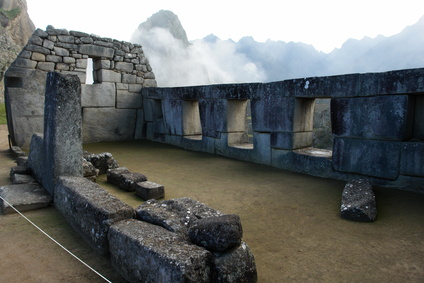The Temple of the Three Windows
 The Temple of the Three Windows is one of the foundations with the longest history in the sacred lost city of Machu Picchu. According to the native indigenous folklore, the city was build up with the purpose to hide the Inca civilization from the Spanish conquerors, and this location was without a doubt more than ideal for such shelter. This Temple held a great spiritual value for the civilization but also has a very important historical meaning.
The Temple of the Three Windows is one of the foundations with the longest history in the sacred lost city of Machu Picchu. According to the native indigenous folklore, the city was build up with the purpose to hide the Inca civilization from the Spanish conquerors, and this location was without a doubt more than ideal for such shelter. This Temple held a great spiritual value for the civilization but also has a very important historical meaning.
The contemporary accounts narrated the difficulty of finding the city of Machu Picchu by outsiders outside the hidden entrances in the forests leading to the Citadel. However, the discoveries made by the community of experts in anthropology, based on the comments of natives of the area (which has been described in much detail the city as its surroundings), showed that the location of Machu Picchu was well known much before its discovery in July 24, 1911 was attributed to the American expeditionary and Dean of the Yale University History Department, Hiram Bingham, which began his studies of archaeology by a mere hobby to exploration. Bingham, due to an error of coordinates, believed to find the Tamputoco or Hill of the Three Windows, sacred place that represents the origin of the Inca civilization.
The area had already been discovered by the various owners and tenants of the numerous holdings covering the area of Machu Picchu, on the slopes of the cordillera de Vilcanota just 80 kilometers from the city of Cuzco; and even makes mention of the existence of this city in the mountains, which was already accessed prior to its subsequent discovery. The Temple of the Three Windows still retains the names engraved in stone of the lessee Agustín Lizárraga and three of his fellow Gabino Sánchez, Enrique Palma and Justo Ochoa, engravings that were made in the 14 July 1902. For this reason, there is no doubt that the Temple of the Three Windows has contributed to greatly know the history of this city.
Apart from the importance of the temple for the history, this building is among the most important of Machu Picchu because of its close location to one of the points with greater spiritual value for civilization, the main Plaza, which is 8 meters away from it, placing the Temple in the eastern part of the square. The temple is located in the lower part of the residential sector Urin.
Consisting of only three walls on a rectangular base and covered by a roof made of adobe walls were constructed from large blocks of solid rock carved in polygonal shape forming a conglomerate of perfectly matched stones each other, leaving space for, originally five Windows, although there are today only three of them indicating the exact location of the sunrise. The roof is supported by a column of stone and the temple hosts a carved stone with engravings that represent the three levels where the Inca civilization divided the Andean world: the sky spirituality (Hanan-Pacha), the Earth's surface or the mundane (Kay-Pacha) and subsoil or inner life (Ukju-Pacha).